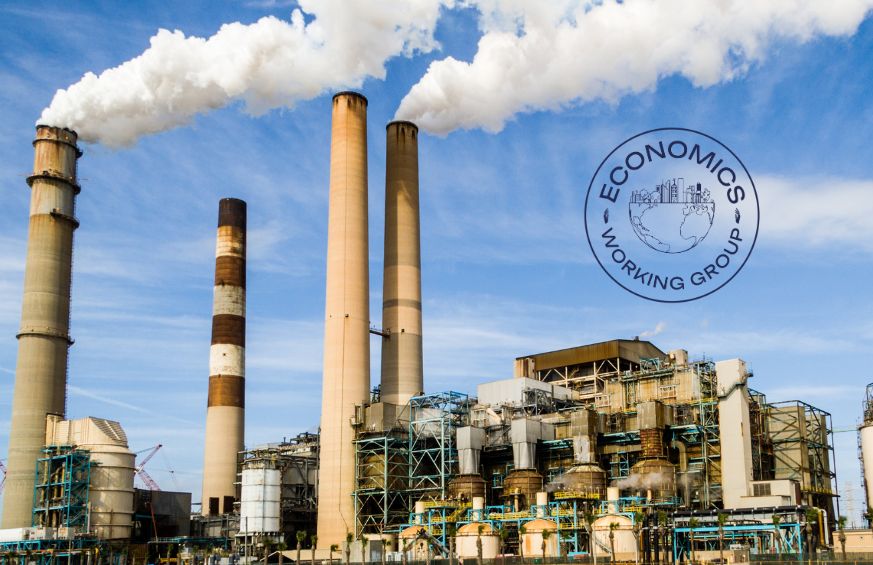The EU’s current industrial policy has been widely endorsed as a shift towards green Keynesianism. Yet, it lacks public control over the innovation process as well as fiscal oversight by the European Parliament, while promoting rentier capitalism and hindering the redistribution of the benefits, the author argues.
This article is part of transform!’s Economics Working Group Blog Series, coordinated by Roland Kulke.
In parallel to global trends, the European Union (EU) has adopted a whole array of industrial policy initiatives in the past decade. Despite industrial policy having been a foundational pillar of European integration, concrete industrial policy initiatives have been somewhat under the radar during the decades of neoliberal restructuring. Around the 2000s, industrial policy came to be rehabilitated as innovation, R&D and human skills policy, marking the proliferation of Public Private Partnerships. Aligning with global counterparts adopting vast industrial policy programmes like Made in China 2025, Make in India, Trump’s America First, the European Commission heralded a European Industrial Renaissance in 2014, paving the way for a more encompassing industrial policy offensive – the European Industrial Strategy, which has been updated ever since.
Presented as a catch-all strategy to the EU’s problems, industrial policy is meant to boost the global competitiveness of EU industries, deliver more high-quality jobs, ensure more cohesion and economic convergence, and also to tackle the pressing issue of climate emergency. In light of escalating geopolitical tensions and an expanding trade deficit with China, coupled with the swift progress of Chinese manufacturers in producing and exporting high value-added products, EU industrial policy also comes with the undertone of Make Europe Great Again. Similar to US President Biden’s Build and Buy America as part of the Infrastructure Investment and Jobs Act of 2021 and the Inflation Reduction Act (IRA) of 2022, the goal is to onshore manufacturing capacity in pivotal industries, diminish dependencies on global supply chains and facilitate corporate access to critical raw materials, and thereby ensure an open strategic autonomy and technological sovereignty, especially in high-tech sectors such as semiconductors, microchips, data cloud technology, and space engineering. A range of EU industrial policy initiatives, like Smart Specialisation, seek to induce an intra-EU value chain industrialisation through regional capacity building and stimulating cross-regional industrial synergies, so that exports eventually can be branded as Made in Europe.
The European Commission is portraying the new EU industrial policy first and foremost as a greening strategy, propelling the EU for the net-zero emission goals set for 2050. Much emphasis is being given to enabling a digital and green twin transition, suggesting that the digitalisation of industries and societies will serve as a key enabler for greening industrial production. However, it is important to realise that enhancing industrial competitiveness is paramount. Although concrete EU industrial policy initiatives are somewhat difficult to trace because industrial policy is cross-cutting various Directorate Generals and blended into existing and new EU policies, as the examples in Table 1 demonstrate, EU industrial policy also entails the European Defence Action Plan of 2016 and the European Defence Fund adopted in 2019 with the aiming of deepening R&D collaboration and the collaboration of the security and defence industry for production of a competitive state-of-the-art and interoperable defence technology and equipment. Confronted with an unfolding imperialist war at the direct borders of the EU, the European Commission currently seeks to amplify the European Defence Industrial Strategy. Moreover, a whole range of flanking policies have been adopted for a faster standard setting, small and lean regulation to improve regulatory fitness and introduce a competitiveness proofing, all for the sake of simplifying or removing existing legislation considered costly for business, as well as for screening new legislation regarding its impact on the global competitiveness of EU industries.

The Green Deal Industrial Plan announced in February 2023 is also testimony to the competitiveness goal enjoying primacy above tackling the climate emergency. The Plan aims at putting Europe’s net-zero industry in the lead. It has been announced as a counter strategy to the above-mentioned US Inflation Reduction Act, which consists of a 400 billion US$ package of conditional subsidies, tax breaks, or loan guarantees to ease investments into cleantech industries like batteries, solar panels, wind turbines, heat pumps, and all sorts of renewables. When EU-based industries, like the European Round Table of Industrialists, started a fear-mongering campaign arguing that the IRA was an existential threat with disastrous consequences for industrial ecosystems that would lead to yet another wave of deindustrialisation, job losses, and overall loss of competitiveness of EU economies, European Commission President Ursula von der Leyen assured that the EU would do everything it can to support European industries in winning the race for leading green technology value chains. To be sure, we do not hear von der Leyen saying that the EU will do ‘whatever it takes’ to decarbonise capitalism. We have seen various reincarnations of the same story over time, such as with the Lisbon Agenda of 2000 and its successor strategy Europe2020, which have aspired to position the EU as the world’s most competitive and knowledge-based economy. Only this time, the competitiveness rhetoric is wrapped up in a sustainable competition and growth language, promising a technosolutional fix to stopping climate change somewhere in a distant future.
Academics and politicians alike have widely endorsed the revitalisation of EU industrial policy as a shift away from the harsh neoliberal structural adjustment of the post-crisis years towards a new green Keynesian interventionism that also addresses the creeping deindustrialisation of EU economies. In fact, a whole battery of left-leaning academics, like Dani Rodrik or Mariana Mazzucato, have outed themselves as proponents of an active entrepreneurial state as a risk taker and market shaper. Committed to changing capitalism rather than abolishing it, Mazzucato actively advises the European Commission to take the lead, invest and stimulate innovation. It is believed that if the state, including state apparatuses like the EU, precedes and makes the first move, private venture capital will follow and ‘capitalism’ will miraculously prosper, with the usual assumed trickle-down effects. Academics also uncritically assume that a more neo-mercantilist or protectionist orientation, or industrial policy for that matter, cannot be neoliberal. The European Commission is portrayed as an honest broker between public and private actors who collectively seek to achieve ‘desirable’ public policy outcomes. The redistributive consequences of the new EU industrial policy, and who is paying for it are seldom explored.
“In essence, the pace of decarbonising capitalism and the much-needed energy transition is contingent upon the decision made by financial capital.”
The European Commission has estimated that more than 700 billion euros per year will be needed for scaling up manufacturing capacities for net-zero technologies and products alone. To ensure that the future of industry is Made in Europe, as Von der Leyen has articulated in her State of the Union address of 2023, even more investment will be imperative. In the context of the strict public deficit and debt rules of the Economic and Monetary Union, EU member states however do not have much fiscal leeway, and the EU has a budget comparable to that of Denmark. By virtue of the Treaties, the EU moreover officially cannot run a deficit or take on debt. This raises the question of how the new EU industrial policy is being financed. Who is paying for it, who is accumulating the profits and who controls the innovation process, and for what purpose?
The new EU industrial policy may convey the impression that it is funded through non-repayable grants or EU-level subsidy schemes. Indeed, some EU industrial policy programmes hinge on public non-reimbursable EU or member state co-financing as a precursor for attracting private investors. Notably, long-standing EU structural funds, like the Cohesion Fund, have been reallocated for concrete industrial policy purposes, and a significant proportion of HorizonEurope is dedicated to financing research and innovation in order to move EU industries ahead of transnational value chains. In addition, the European Commission temporarily lifted state aid control for public investments in net-zero technologies and adopted a Block Exemption Regulation for state aid to the same industries as those covered by the US Inflation Reduction Act, alongside a vast relaxation of state aid rules for Important Projects of Common European Interest (IPCEI), one of the EU’s flagship industrial policy programmes. In January this year, the European Commission even went as far as allowing the German government to top the level of state aid that Northvolt, a Swedish battery producer, had already secured under the US regime to ensure that the production plant for battery cells would be built in Schleswig-Holstein rather than in the US.
State aid, however, goes beyond state institutions splashing with cash in the form of direct subsidies: it also includes guaranteed preferential public procurement contracts, reduced tax rates or other favourable tax arrangements, friendly loans or interest rate subsidies, financial support for investments or R&D projects and – importantly – public guarantees and other financial instruments that share or absorb private investment risks. Particularly, seducing financial capital to invest through public risk mitigation, or to use the language of the European Commission, through ‘crowding in’ investors, is gaining ever more prominence. The European Commission uses a vast range of risk-absorbing financial gimmicks that share or absorb a part of the risks of providing loans, equity or quasi-equity investments by using the EU budget, sometimes in combination with the liquidity reserves of the European Investment Bank (EIB) Group, as a sort of revolving guarantee fund.
“… the chosen name for the risk-bearing facility that has been created in 2019 to unlock private investments is InvestEU, and not EUInvest, as the EU does not invest.”
The creation of a safe harbour for private investors in the form of guarantees, counter guarantees or other risk-sharing facilities should trigger the investment appetite of a broad range of financial capital entities, including commercial banks, institutional investors, sovereign wealth funds, private equity, angel investors, and venture funds. The EU has experimented with such instruments in the context of financing Private Public Partnerships since the 1990s. Within development finance, such instruments have been standard practice as the work of Daniela Gabor demonstrates. Within EU industrial policy, using the artillery of public guarantees covering potential investor losses should minimise the budgetary outlays of the public sector, while at the same time create a multiplier effect and leverage ever more private investments into manufacturing. It is quite telling in this regard that the chosen name for the risk-bearing facility that has been created in 2019 to unlock private investments is InvestEU, and not EUInvest, as the EU does not invest.
Channelling investments away from the speculative activities in the bloated financial sector to the real production sphere may sound politically more appealing than ramping up state aid levels in the form of non-reimbursable grants. However, crowding in financial capital by using the EU budget as a guarantee over and over again is problematic in several respects. To begin with, it has considerable re-distributional costs: while the risks of private investors are socialised, often without strings attached, the rewards (profits) remain privatised. There is neither a profit-sharing nor a participatory role of (organised) labour, or society at large with regards to the decision-making about the reinvestment of publicly facilitated profits. Furthermore, within set parameters, it is financial capital that decides who can and who cannot receive a loan or an equity investment on the basis of EU guarantees. It is also financial capital that decides about the financing conditions – the amount, the duration, interest rates and fees. In essence, the pace of decarbonising capitalism and the much-needed energy transition is contingent upon the decision made by financial capital.
Crowding in financial capital through the deployment of EU budget guarantees is crowding out the oversight of the European Parliament. Already in 2017, the European Parliament, the democratic control institution for the EU budget, complained about the highly complex and opaque galaxy of funds and instruments around the EU budget. As these risk-absorbing instruments can be combined, or blended with other forms of financial support, such as direct grants from one of the EU’s 43 funds or state aid, a labyrinth of hybrid financing channels for EU industrial policy programmes has emerged. Ironically, even the European Commission seems to have lost oversight as it had to hire experts on temporary contracts to manage EU debt operations. To pre-empt losing control entirely, a new post called Chief Risk Officer has been established, charged with the task of monitoring the risk-absorbing instruments.
The EU industrial policy efforts seem contradictory: public money is used to seduce financial capital into investing in the manufacturing industries, yet those are less investing in the realm of production than in non-productive activities.
Although a Common Provisioning Fund has been set up as a safety buffer for contingent liabilities that can potentially induce losses in the annual EU budget, it remains unclear how potential defaults will be covered should the Fund be exhausted, and whether and how the European Parliament would be involved should defaults affect the EU budget. The question of democratic control is becoming even more pertinent now that the European Commission, based on the triple-A rating of the EU-27 and authorised by the Council, is raising money on capital markets for financing industrial policy programmes like NextGeneration EU. If we are to believe Von der Leyen, raising money on capital markets is generally accepted and discussions merely concern the size. Little attention is being paid that the EU, through its budgetary guarantees, is gradually transforming into a sort of Lehman Brothers, whose downfall in 2008 was linked to the issuance of ever more debt instruments through offshore financial centres, all guaranteed by Lehman Brothers Holding Inc.. When defaults occurred, this amounted in a severe shortage of capital to cover losses. Although a Lehman-Brothers-like scenario may appear unlikely, the issuance of guarantees carries financial risks that now partially go unchecked by the European Parliament whose approval powers are restricted to the EU budget.
EU industrial policy more generally fosters the continuation of debt-led accumulation regimes and the growing prominence of rentier capitalism, a parasitic form of capital accumulation through extracting rent from the ownerships or control of scarce assets rather than actual production. The envisioned reindustrialisation of the EU is being subsidised by debt – debt to pump the economy. The issuance of debt, and the trading of debt instruments is only one instance of rentier capitalism. Corporations investing in non-productive activities, such as using their liquidity or even debt to finance share buybacks or make dividend payments to shareholders, also fall into the rentier capitalism category. For example, as a report by SOMO reveals, shareholder remunerations in the Netherlands have increased by 500 percent over the past 20 years, while debt levels have also increased significantly. Rentier capitalist tendencies also surface with mergers and acquisitions, which are often conducted to absorb monopoly rents and get access to intangibles such as patents and other forms of intellectual property, or goodwill. In a context where corporate investments in non-productive activities often exceed investments in R&D and in fixed direct production related assets, the EU industrial policy efforts geared at crowding in financial capital seem utterly contradictory: public money is being used to seduce financial capital into investing in manufacturing industries which are themselves not investing in the realm of production.
Debt-financed industrial policy also has major implications for the goal of climate neutrality. Indebtedness is not only leading to financial instability but it also comes with a giant ecological footprint. To service debt payments, economies have to grow, and growth based on technological breakthroughs is not automatically free from greenhouse gas emissions, resource extraction and energy consumption. Debtors eventually will have to prioritise short-term economic growth over long-term ecological and social sustainability, which raises the question of how much more debt we can afford within our planetary boundaries. Debt-financed technological fixes as an alleged solution to climate change is on multiple fronts an act of procrastination, discounting on the future.
“… it is pivotal that the Left in Europe not only challenges the redistributive costs of EU industrial policy but also its very content, form and scope, and the primacy given to narrow conceptions of competitiveness.”
European integration is pervaded by a North-South, as well as an East-West divide, and EU industrial policy in many ways is exacerbating intra-EU asymmetries. Furthermore, the focus on global competitiveness through the use of public resources to crowd in financial capital and invest in geopolitically important high-tech sectors implies that only a small number of regions, corporations and workers will benefit, notably those regions where high-tech industries are already concentrated, with relatively little effects on job creation elsewhere. The earlier-mentioned EU “Smart Specialisation” flagship programme is probably the epitome of how industrial policy enlarges structural disparities across the EU. This place-based neoliberal supply-side strategy, which seeks to upscale regional manufacturing clusters with “Industry 4.0”-type technologies, has been blended into the EU Cohesion Fund and thus subordinated to the goal of “economic, social and territorial cohesion, balanced economic growth and upward economic convergence” as enshrined in the Single European Act of 1987. While it is not only questionable whether “specialising smart” in industrial niches rather than diffusing investments into multiple domains is a viable and also a sustainable catching-up strategy for all regions, Smart Specialisation runs counter to the goal of economic convergence. As all regions, including advanced regions, are simultaneously upgrading regional industrial structures, this corroborates the status quo of structural asymmetries. Not every region can become the next Silicon Valley. Lagging regions with low technology-intensive, low skill, and low value-added sectors, often identify tourism – with its economic spin-offs in the local agri-food production, gastronomy sector, and the cultural and creative industry – as trailblazing investment areas. In contrast, high technology-intensive export-led innovation leaders or frontrunner regions with higher R&D activities and a higher readiness to make the transition to Industry-4.0 production tend to have not only comparatively larger Smart Specialisation projects but also better-funded projects, as they are more likely to crowd in private investors.
EU industrial policy is yet another instance of offensive capitalist restructuring, primarily to the benefit of financial and productive capital, without any notion of profit sharing for labour or the creation of common goods accessible to society at large. In view of the upcoming European Parliament elections in June this year, it is pivotal that the Left in Europe not only challenges the redistributive costs of EU industrial policy but also its very content, form and scope, and the primacy given to narrow conceptions of competitiveness. Capitalism’s quest for economic growth is infinite within a finite planet, and we do not have the luxury to retreat in a collective form of lethargic stupor. We have to take difficult and painful political decisions now, rearrange our priorities and put systemic change upfront, rather than competitiveness and the goal to outcompete the world. We urgently need a discussion about how to fundamentally alter the ownership and control of productive structures, and how to move towards a labour-centred, inclusive and environmentally sustainable development that at the same time be also democratic, thereby taking into account the role of labour domestically and globally. Without the assumption that a different world were possible, there would be no need for politics. The European Left is not only capable but also uniquely placed to champion such a discussion for an alternative future.
By Angela Wigger, Associate Professor Global Political Economy, Radboud University, The Netherlands, angela.wigger@ru.nl



